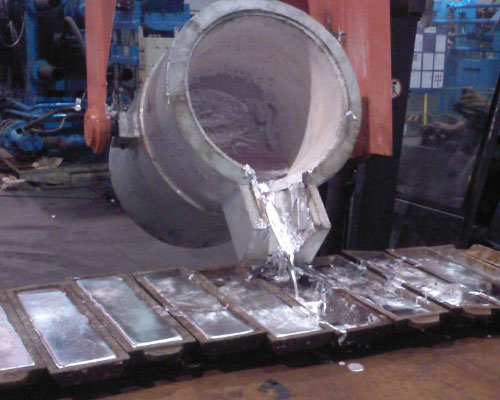Aluminium Alloy Melting is a process in which a solid heats up and becomes a fluid liquid. After the feeding is completed, melting starts. During the smelting process, it is necessary to ensure that the melting is fast and uniform, and the temperature near the flame is high, reaching more than 1200 ℃. In order to avoid local overheating and excessive temperature, the aluminum alloy oxidation will cause serious inconvenience to the later product refining. Stirring should be carried out, and the unmelted furnace charge should be squeezed into the aluminum liquid, so that almost all of it is immersed in the stirring to avoid local overheating. For the final immersion of Mg and other elements, the flame cannot be directly heated and melted, and because the aluminum liquid is immersed in the raw material, the temperature is reduced, and the Mg and other elements are melted at a relatively low temperature, which reduces the burning loss and improves the combustion efficiency.
Aluminium Alloy Melting
The aluminum alloy begins to melt at about 600 ℃, and it will melt when heated to 660 ℃. The melting temperature should not exceed 760 ℃. When the melting temperature exceeds 770 ℃, the aluminum alloy is seriously oxidized, hydrogen absorption and slag inclusion increase during the melting process, and coarse grains appear during the casting and solidification process, which reduces the mechanical properties. In order to reduce the oxidation of the aluminum alloy during the melting process, 0.4% to 0.5% of the covering agent is added during the melting process to protect the aluminum oxide film from being damaged. The type of covering agent is similar to the chemical composition of the slag cleaning agent.

The temperature of the aluminium alloy smelting is controlled at 720 ~ 760 ℃. After the aluminum ingot is melted, raw materials with higher melting points such as Si element and Ti agent are added. Ti forms heterogeneous crystal nuclei in the alloy, which plays a role in refining the structure and pressing it into Melt in aluminum liquid to reduce burning loss. After the aluminum ingot is basically melted, alloy elements such as Mg and Cu, which are easily burned, are added. It cannot be added too early to reduce the burning loss, nor too late, which affects the diffusion and causes segregation. Close the furnace door and continue smelting.
After smelting is complete, there are a lot of scum on the surface of the aluminum alloy, mainly Al2O3 and other oxide inclusions. These fine inclusions are heavier than the aluminum liquid, but after aggregation and agglomeration, the specific gravity is lighter and floats on the surface. Slag removal is required. The dosage of slag removing agent is added according to 0.2%~0.5%, evenly sprinkle on the surface of the aluminum liquid, and perform shallow uniform stirring. Put the slag on the furnace door, close the door and let it stand, on the one hand, the slag cleaning agent has a heating effect, which can melt the aluminum liquid adhering to the scum; on the other hand, it can effectively separate the slag from the aluminum liquid, which is beneficial to the slag Aluminum slag, after standing for a few minutes, smoothly remove the aluminum slag from the furnace door. Aluminum alloy melting is a very complicated process. Due to the inconsistent burning loss of different elements, after the slag is stripped, the aluminum liquid needs to be sampled for physical and chemical analysis to ensure that each element can only be discharged into the transfer range within the qualified range. Ladle degassing and refining, otherwise it needs to be properly adjusted.

